Do Charitable Foundations Spend Money Where People Need It Most? A Spatial Analysis of China
Abstract
:1. Introduction
2. Data and Methods
2.1. Charitable Foundation Data
2.2. Local Population Need Data
2.3. Spatial Analysis Methods
3. Results
3.1. Statistical Summary of the Attributes of Charitable Foundations
3.2. Spatial Distribution of Charity Expenditures
3.3. Spatial Clusters of Participants and Expenditures of Charitable Foundations
3.4. Characterizing Local Population Needs
3.5. Relationships between Charity Expenditures and Local Population Needs
4. Discussion and Conclusions
Acknowledgments
Author Contributions
Conflicts of Interest
References
- Bugg-Levine, A.; Kogut, B.; Kulatilaka, N. A new approach to funding social enterprises. Harv. Bus. Rev. 2012, 90, 118–123. [Google Scholar]
- Rijpma, A. Funding Public Services through Religious and Charitable Foundations in the Late-Medieval Low Countries; Utrecht University: Utrecht, The Netherlands, 2012. [Google Scholar]
- Xiaoming, F. China’s charitable foundations: Development and policy-related issues. Chin. Econ. 2015, 48, 130–154. [Google Scholar] [CrossRef]
- Spielman, D.J.; Kolady, D.E.; Ward, P.S. The prospects for hybrid rice in India. Food Secur. 2013, 5, 651–665. [Google Scholar] [CrossRef]
- Almog-Bar, M.; Schmid, H. Advocacy activities of nonprofit human service organizations: A critical review. Nonprofit Volunt. Sect. Q. 2014, 43, 11–35. [Google Scholar] [CrossRef]
- Bebbington, A. NGOs and uneven development: Geographies of development intervention. Prog. Hum. Geogr. 2004, 28, 725–745. [Google Scholar] [CrossRef]
- Fruttero, A.; Gauri, V. The strategic choices of NGOs: Location decisions in rural Bangladesh. J. Dev. Stud. 2005, 41, 759–787. [Google Scholar] [CrossRef]
- Kareithi, R.; Flisher, A. Location of development NGOs providing HIV and AIDS services to young people in Cape Town, South Africa. J. Soc. Dev. Afr. 2009, 24. [Google Scholar] [CrossRef]
- Never, B.; Westberg, D. Place Matters: The Spatial Effects of Human Service Expenditures. In Nonprofit Policy Forum; De Gruyter: Berlin, Germany, 2016. [Google Scholar]
- Holmes, G.; Scholfield, K.; Brockington, D. A comparison of global conservation prioritization models with spatial spending patterns of conservation nongovernmental organizations. Conserv. Biol. 2012, 26, 602–609. [Google Scholar] [CrossRef] [PubMed]
- MacLean, L.M.; Brass, J.N.; Carley, S.; El-Arini, A.B.; Breen, S. Democracy and the distribution of NGOs promoting renewable energy in Africa. J. Dev. Stud. 2015, 51, 725–742. [Google Scholar] [CrossRef]
- Zhou, M. Global Distribution of Transnational Human Rights NGOs: The Effects of Domestic Resources and Institutions. Sociol. Inq. 2015, 85, 576–599. [Google Scholar] [CrossRef]
- Galway, L.P.; Corbett, K.K.; Zeng, L. Where are the NGOs and why? The distribution of health and development NGOs in Bolivia. Glob. Health 2012, 8, 38. [Google Scholar] [CrossRef] [PubMed]
- Hastie, T.J.; Tibshirani, R.J. Generalized Additive Models; CRC Press: Boca Raton, FL, USA, 1990; Volume 43. [Google Scholar]
- Ma, J.; Wang, Q.; Dong, C.; Li, H. The research infrastructure of Chinese foundations, a database for Chinese civil society studies. Sci. Data 2017, 4, 170094. [Google Scholar] [CrossRef] [PubMed]
- Research Infrastructure of Chinese Foundation. Research Infrastructure of Chinese Foundation Database. 2017. Available online: http://ricf.org.cn/ (accessed on 17 February 2017).
- Kulldorff, M. A spatial scan statistic. Commun. Stat. Theory Methods 1997, 26, 1481–1496. [Google Scholar] [CrossRef]
- Anselin, L. Local indicators of spatial association—LISA. Geogr. Anal. 1995, 27, 93–115. [Google Scholar] [CrossRef]
- Anselin, L.; Syabri, I.; Kho, Y. GeoDa: An introduction to spatial data analysis. Geogr. Anal. 2006, 38, 5–22. [Google Scholar] [CrossRef]
- Song, Y.-Z.; Yang, H.L.; Peng, J.H.; Song, Y.R.; Sun, Q.; Li, Y. Estimating PM 2.5 Concentrations in Xi’an City Using a Generalized Additive Model with Multi-Source Monitoring Data. PLoS ONE 2015, 10, e0142149. [Google Scholar] [CrossRef] [PubMed]
- Wood, S. Generalized Additive Models: An Introduction with R; CRC Press: Boca Raton, FL, USA, 2006. [Google Scholar]
- Song, Y.; Ge, Y.; Wang, J. Spatial distribution estimation of malaria in northern China and its scenarios in 2020, 2030, 2040 and 2050. Malar. J. 2016, 15, 345. [Google Scholar] [CrossRef] [PubMed]
- Zhang, T.; Lin, G. Asymptotic properties of spatial scan statistics under the alternative hypothesis. Bernoulli 2017, 23, 89–109. [Google Scholar] [CrossRef]
- Ge, Y.; Song, Y.; Wang, J.; Lu, B. Geographically weighted regression-based determinants of malaria incidences in northern China. Trans. GIS 2017, 21, 934–953. [Google Scholar] [CrossRef]
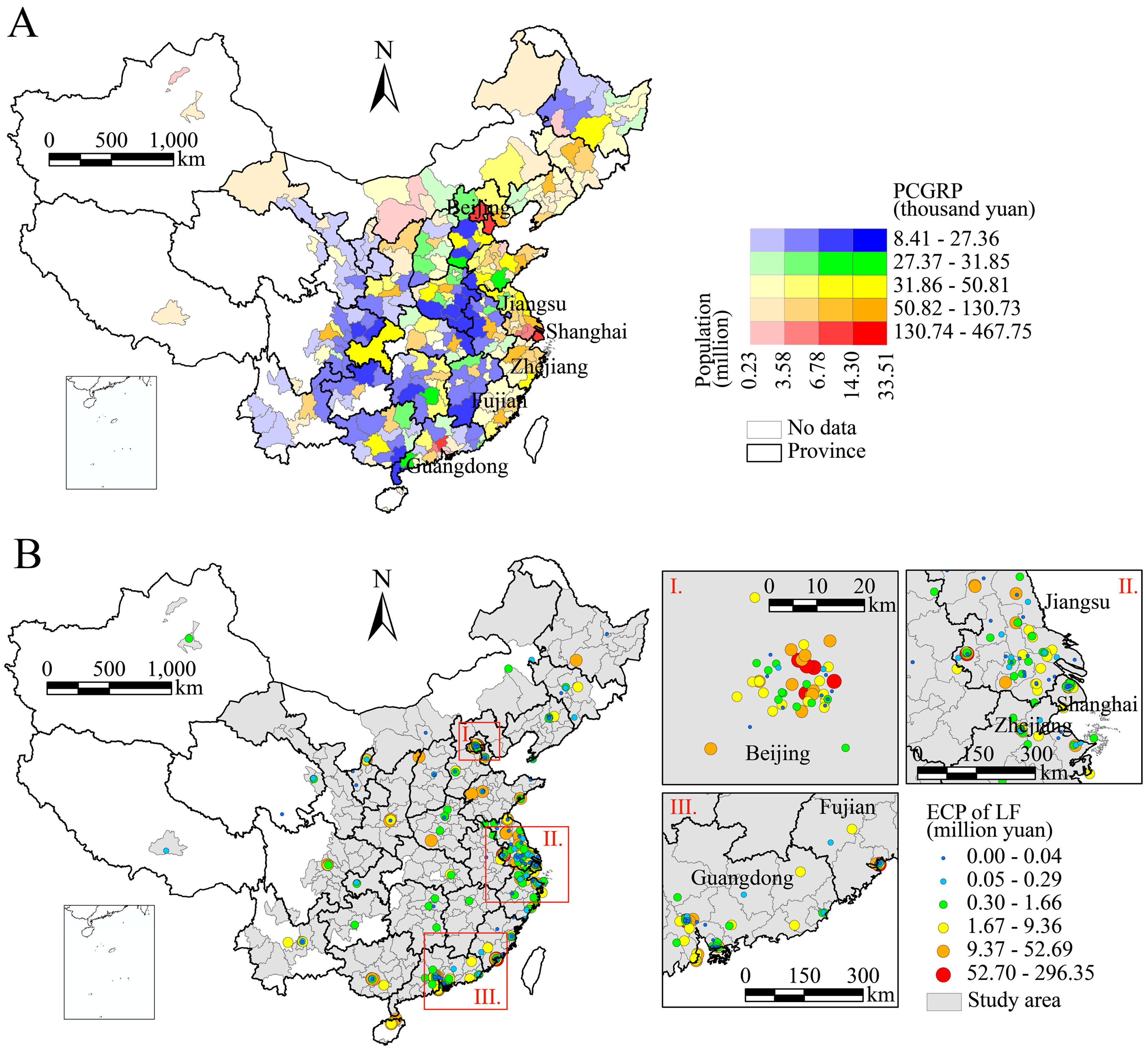
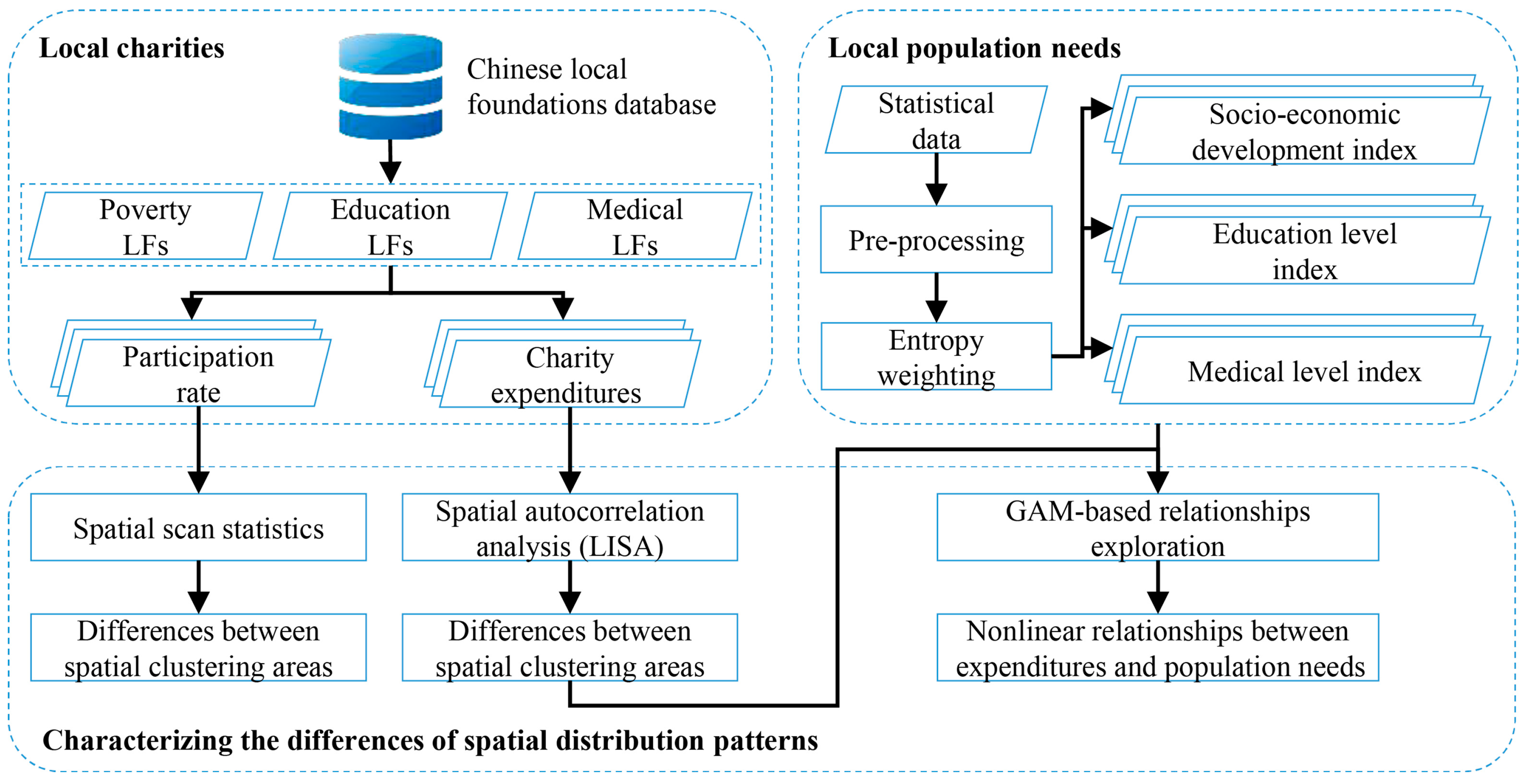
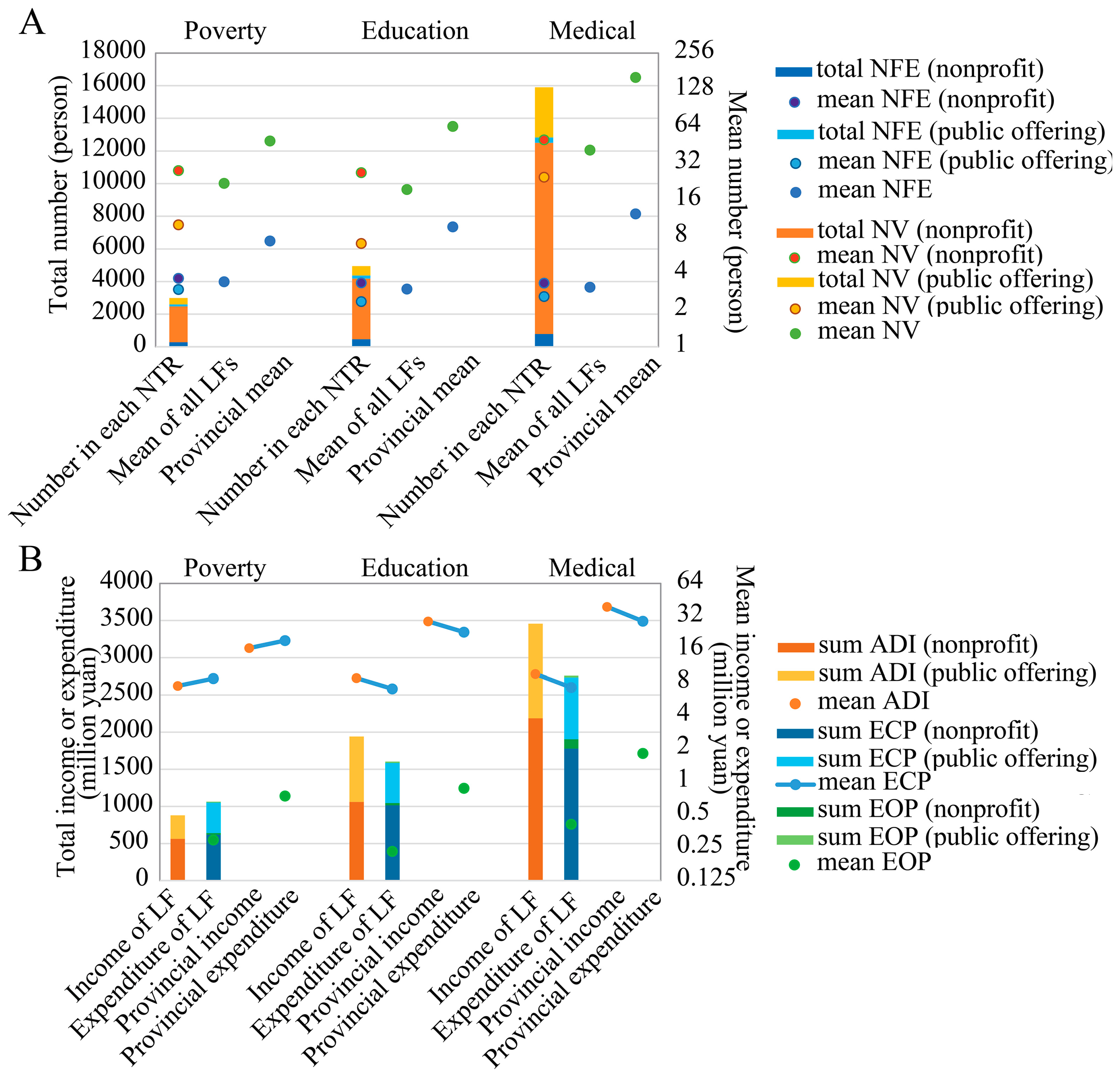
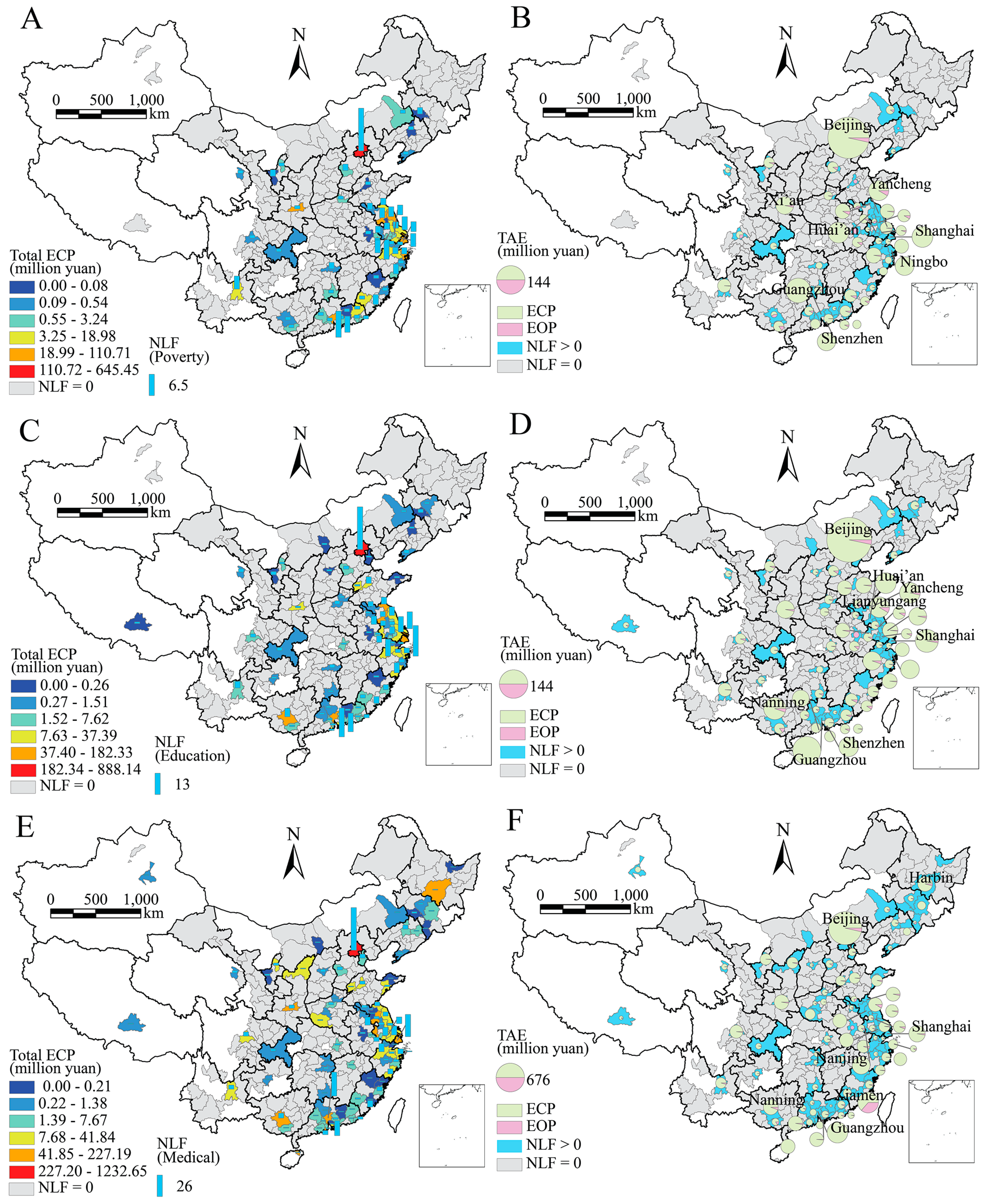
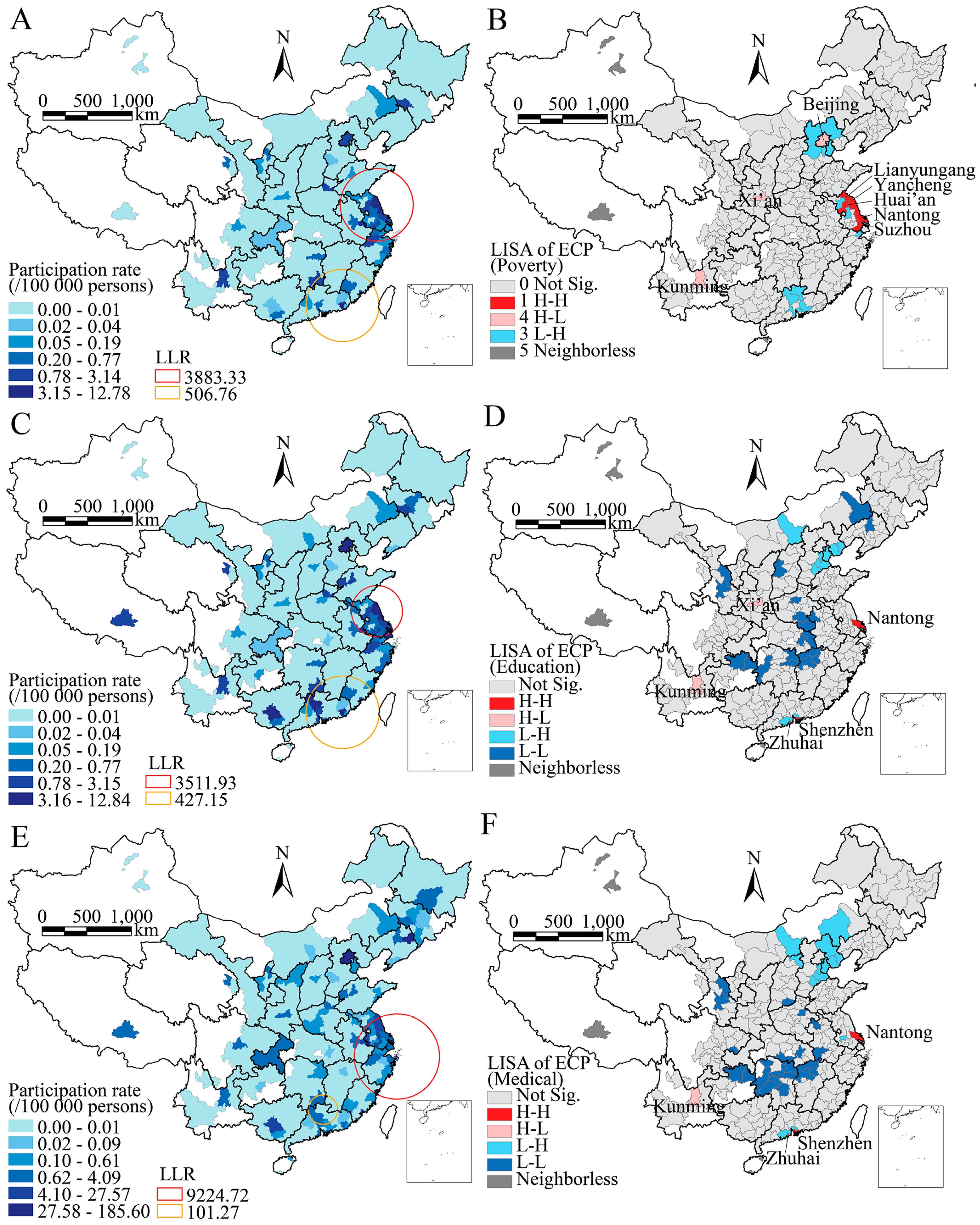
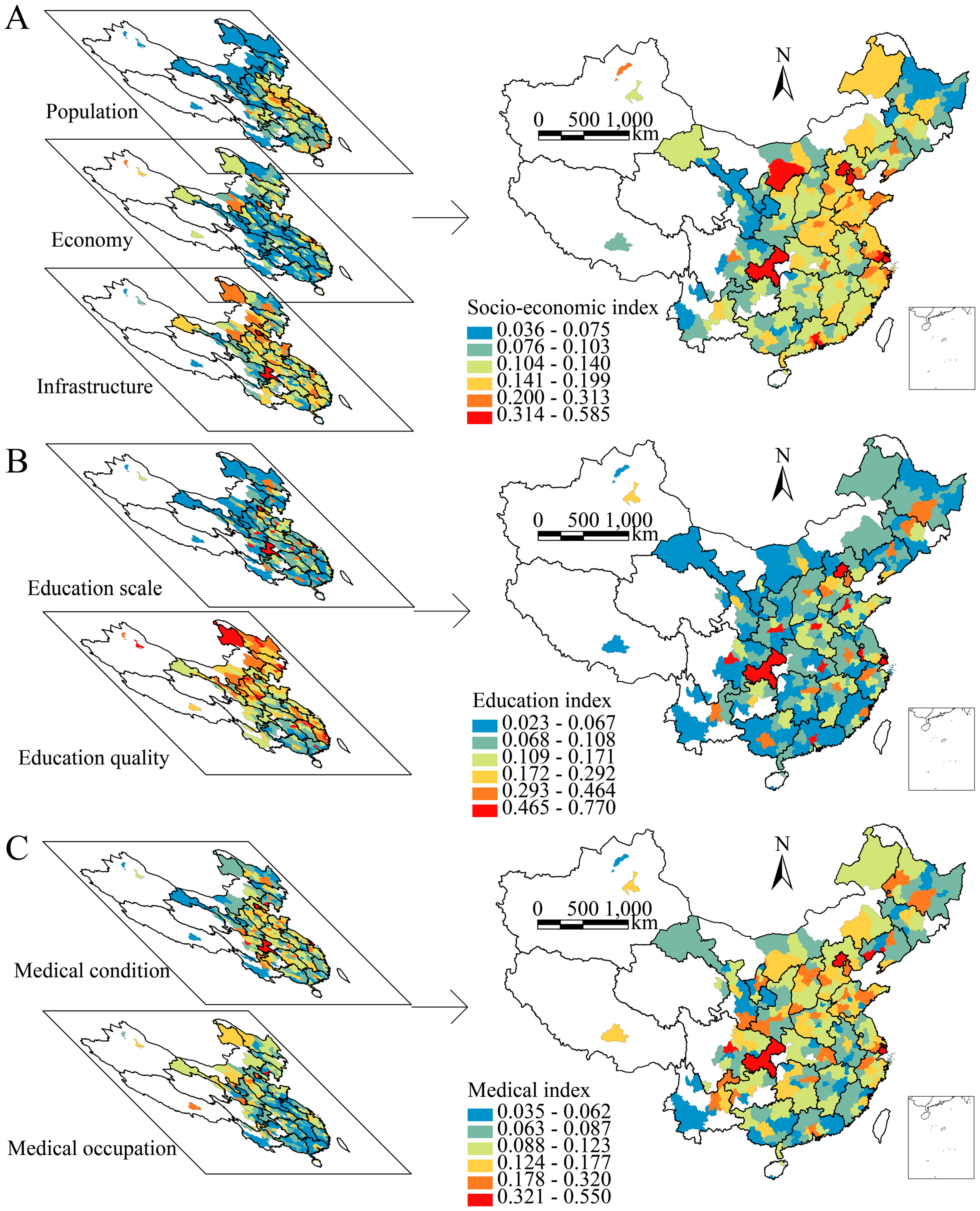
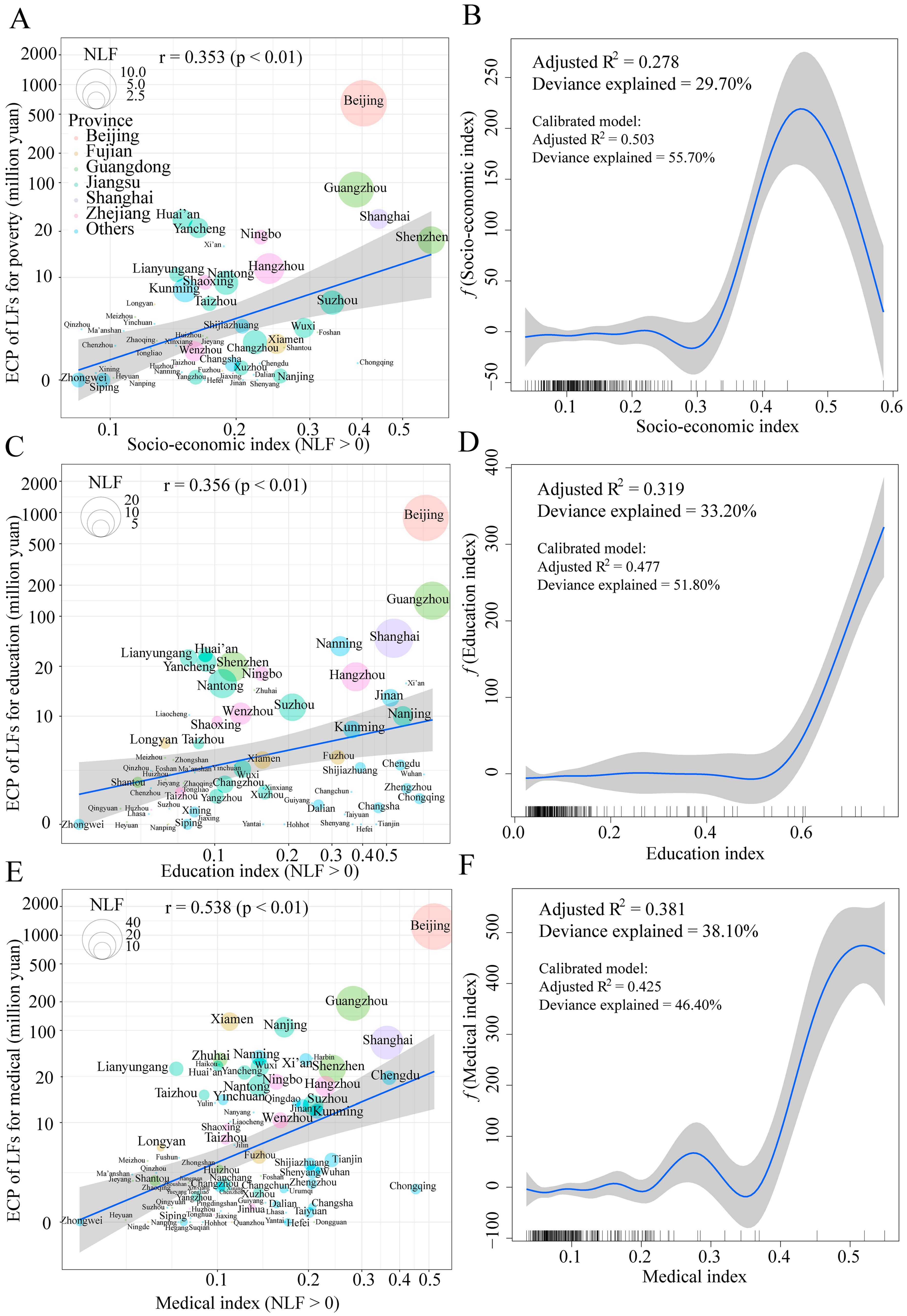
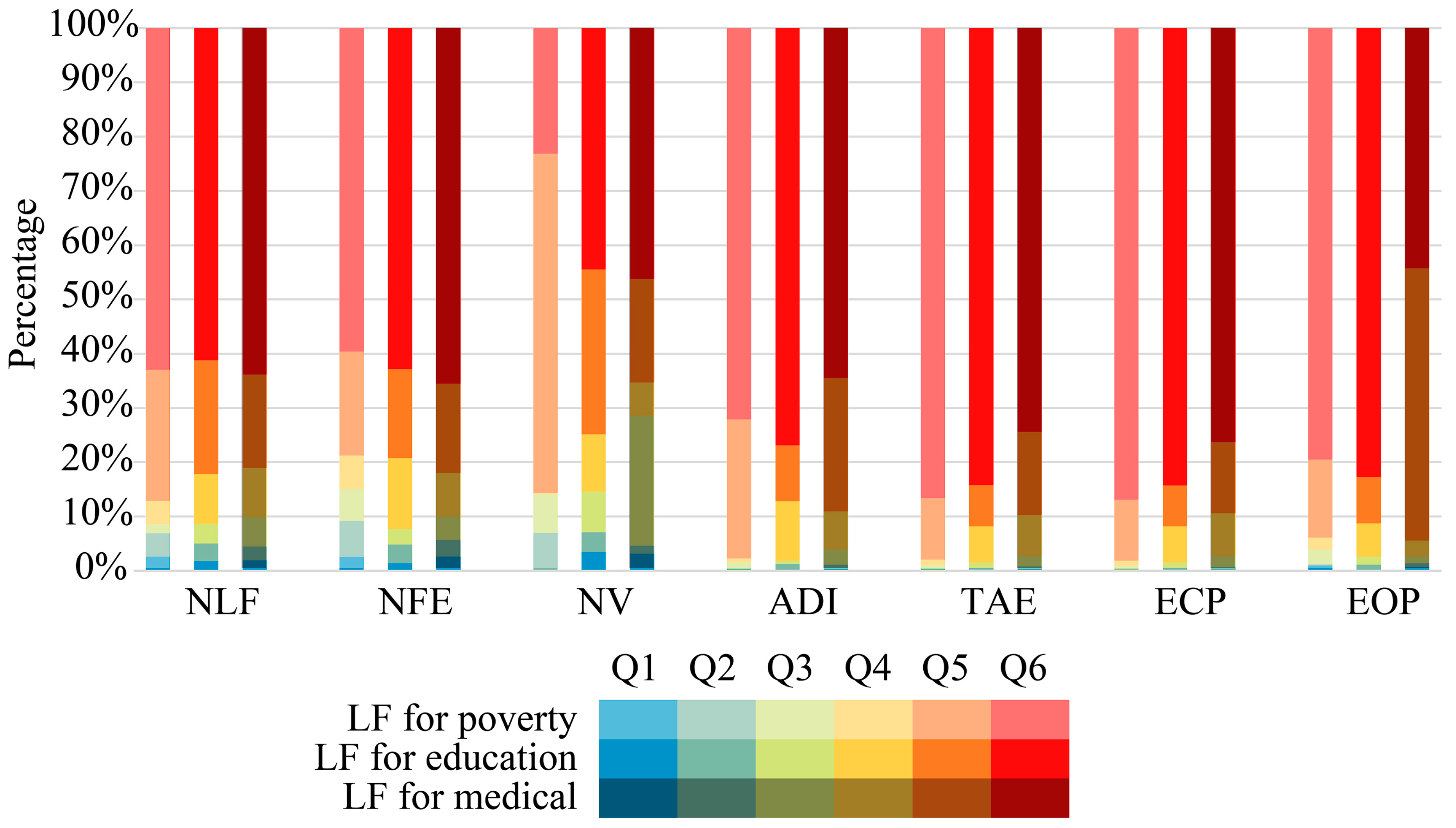
| Index | Sub-Index | Variable | Min. | Mean (sd.) | Max. |
|---|---|---|---|---|---|
| Poverty index | high → low | ||||
| Socioeconomic development level | low → high | ||||
| Population | P1: Population density (million persons/km2) | 6.10 | 428.98 (333.36) | 2607.08 | |
| P2: Population growth rate (%) | −7.00 | 7.22 (8.26) | 113.00 | ||
| Economy | P3: Per capita GRP (yuan/person) | 8407 | 51,216 (48,214) | 467,749 | |
| P4: GRP growth rate (%) | −19.38 | 9.75 (4.89) | 23.96 | ||
| Infrastructure | P5: Major road density (km/km2) | 130.60 | 1704.31 (1098.36) | 10,794.25 | |
| Education needs | high → low | ||||
| Education level | low → high | ||||
| Education scale | E1: Number of colleges | 0.00 | 8.42 (14.75) | 89.00 | |
| E2: Number of primary and secondary schools | 32.00 | 930.58 (733.64) | 6149.00 | ||
| E3: Number of full-time teachers in colleges | 0.00 | 5134 (10179) | 66,026 | ||
| E4: Number of full-time teachers in primary and secondary schools | 2087 | 36,525 (24,802) | 248,724 | ||
| E5: Number of students in colleges | 0.00 | 88,990 (161,470) | 983,051 | ||
| E6: Number of students in primary and secondary schools | 42,996 | 691,733 (515,530) | 5,355,402 | ||
| Education quality | E7: Students enrollment in colleges per 10,000 persons | 0.00 | 275.36 (167.67) | 1210.00 | |
| E8: Teacher-student ratio (%) | 3.75 | 5.58 (0.97) | 10.27 | ||
| Medical needs | high → low | ||||
| Medical level | low → high | ||||
| Medical condition | M1: Number of hospitals and health centers | 0.00 | 245.16 (294.55) | 3052.00 | |
| M2: Number of beds in hospitals and health centers | 0.00 | 18,964 (16,522) | 136,700 | ||
| M3: Number of doctors | 828 | 9290 (8866) | 85,819 | ||
| Medical occupation | M4: Hospitals and health centers per 1,000,000 persons | 0.00 | 69.32 (110.23) | 1090.00 | |
| M5: Beds in hospitals and health centers per 1000 persons | 0.00 | 4.38 (1.56) | 13.31 | ||
| M6: Doctors per 1000 persons | 0.71 | 2.15 (1.03) | 8.48 | ||
| Foundation Type | Cluster Hierarchy | Radius (km) | Number of Cities | Total Number of Participants | Ratio of Regional to National Participants (%) | Participation Rate (/100,000 Persons) | Regional Participation Rate Divided by National Rate |
|---|---|---|---|---|---|---|---|
| LF for poverty | 1st | 408.29 | 37 | 1776 | 59.72% | 0.891 | 3.791 |
| 2nd | 408.22 | 25 | 519 | 17.45% | 0.504 | 2.147 | |
| LF for education | 1st | 120.16 | 20 | 2245 | 45.45% | 1.858 | 4.761 |
| 2nd | 116.12 | 25 | 823 | 16.66% | 0.800 | 2.050 | |
| LF for medical | 1st | 473.90 | 29 | 5626 | 37.18% | 4.209 | 3.520 |
| 2nd | 113.77 | 5 | 558 | 3.69% | 2.295 | 1.920 |
| Foundation Type | Cluster Type | Number of Cities | Total ECP * | Ratio of Regional to National Total ECP (%) | Mean ECP (sd. **) | Regional Mean ECP Divided by National Mean ECP |
|---|---|---|---|---|---|---|
| LF for poverty | H-H | 5 | 100.51 | 9.85% | 20.10 (14.89) | 5.692 |
| H-L | 3 | 645.45 | 63.24% | 224.81 (297.50) | 63.661 | |
| L-H | 14 | 4.11 | 0.40% | 0.29 (0.67) | 0.082 | |
| L-L | 0 | 0 | 0.00% | / | / | |
| LF for education | H-H | 3 | 72.43 | 4.69% | 24.14 (5.80) | 4.522 |
| H-L | 2 | 28.98 | 1.88% | 14.49 (7.03) | 2.714 | |
| L-H | 10 | 3.16 | 0.20% | 0.32 (0.95) | 0.060 | |
| L-L | 19 | 4.78 | 0.31% | 0.25 (0.55) | 0.047 | |
| LF for medical | H-H | 3 | 113.45 | 4.50% | 37.82 (9.50) | 4.339 |
| H-L | 1 | 13.4 | 0.53% | 13.40 (0.00) | 1.537 | |
| L-H | 14 | 8.22 | 0.33% | 0.59 (1.19) | 0.068 | |
| L-L | 22 | 5.55 | 0.22% | 0.25 (0.62) | 0.029 |
| Index | Sub-Index | Weight for Sub-Index | Variable | Weight for Variable |
|---|---|---|---|---|
| Socioeconomic development level | Population | 0.284 | P1 | 0.203 |
| P2 | 0.081 | |||
| Economy | 0.399 | P3 | 0.384 | |
| P4 | 0.015 | |||
| Infrastructure | 0.317 | P5 | 0.317 | |
| Education level | Education scale | 0.901 | E1 | 0.217 |
| E2 | 0.071 | |||
| E3 | 0.256 | |||
| E4 | 0.056 | |||
| E5 | 0.234 | |||
| E6 | 0.066 | |||
| Education quality | 0.099 | E7 | 0.054 | |
| E8 | 0.045 | |||
| Medical level | Medical condition | 0.621 | M1 | 0.233 |
| M2 | 0.162 | |||
| M3 | 0.225 | |||
| Medical occupation | 0.379 | M4 | 0.246 | |
| M5 | 0.029 | |||
| M6 | 0.105 |
© 2018 by the authors. Licensee MDPI, Basel, Switzerland. This article is an open access article distributed under the terms and conditions of the Creative Commons Attribution (CC BY) license (http://creativecommons.org/licenses/by/4.0/).
Share and Cite
Song, Y.; Fu, L. Do Charitable Foundations Spend Money Where People Need It Most? A Spatial Analysis of China. ISPRS Int. J. Geo-Inf. 2018, 7, 100. https://doi.org/10.3390/ijgi7030100
Song Y, Fu L. Do Charitable Foundations Spend Money Where People Need It Most? A Spatial Analysis of China. ISPRS International Journal of Geo-Information. 2018; 7(3):100. https://doi.org/10.3390/ijgi7030100
Chicago/Turabian StyleSong, Yongze, and Linyun Fu. 2018. "Do Charitable Foundations Spend Money Where People Need It Most? A Spatial Analysis of China" ISPRS International Journal of Geo-Information 7, no. 3: 100. https://doi.org/10.3390/ijgi7030100
APA StyleSong, Y., & Fu, L. (2018). Do Charitable Foundations Spend Money Where People Need It Most? A Spatial Analysis of China. ISPRS International Journal of Geo-Information, 7(3), 100. https://doi.org/10.3390/ijgi7030100






